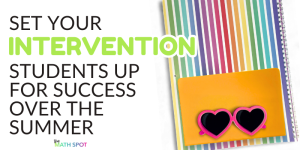Far and away, the math topic I am asked most about this time of year is rounding. Why is rounding numbers so tricky for our students? Let’s dive into the reasons why rounding is so difficult for some of our students, what we can do to mitigate those difficulties and what rounding can teach us about other areas of instruction.

Why is Rounding Numbers So Difficult for Some Students?
Rounding is, essentially, asking a student to tell you which benchmark number a given number is closer to. Over the years teachers have collected rhymes, anchor charts and chants that make this task more manageable for students- but why is this necessary?
In order to round numbers, students need to have both place value understanding and number sense. A student needs to identify:
- What the benchmark numbers are. EX: If we are rounding to the nearest ten, can the student count by tens?
- What benchmark numbers a given number falls between. EX: If we are rounding 46 to the nearest 10, can the student identify that 46 is between 40 and 50?
- Which benchmark number a given number is closest to. EX: If we are rounding 46 to the nearest ten, does the student recognize that 46 is closer to 50 than 40?
Identifying benchmark numbers and naming the two closest numbers are exercises in place value understanding. Recognizing which benchmark is closest to a given number is an exercise in number sense- does a student have an internal number line?
How Can We Support Our Students?
I have written a number of blog posts that recommend the direct steps you can take to support your students in developing the skills needed to successfully round. You can find those posts HERE and HERE.
If you take nothing else away from this post, recognize this, teaching students how to round numbers is not about teaching “how to round”. If you attack rounding from the angle of underlining the place being rounded and drawing an arrow to the place next door you *might* support some students, but you will have done nothing to get to the heart of the place value and number sense necessary for a student to understand rounding.
If a student is confident in their understanding of place value and their internal number line, rounding is a simple skill!
We can best support students in developing their ability to round by doing activities that:
- Encourage skip counting by benchmark numbers
- Supporting students fluency with the count sequence.
- Placing numbers on a number line where benchmark numbers have been noted “Where would 37 fit on this number line?”
- Strengthening 5 and 10 as benchmarks whereas 5 is the midpoint and groups of 10 are the end points.
What Can Rounding Teach Us About Other Areas of Instruction?
Rounding rhymes, tricks, anchor charts, etc are all band-aids that can help a student to round numbers without addressing the underlying place value and number sense that make this skill difficult for our students.
This is not the only area of instruction where this occurs! As our students move into higher grade levels, an increasing number of “missing foundational understandings” causes more and more tricks to creep into instruction.
A student who struggles with rounding will also, likely, struggle to calculate elapsed time- an activity that relies on benchmark numbers and an internal number line. They will also likely struggle with skills like comparing fractions based on reasoning. They won’t quickly and automatically understand that 3/8 is less than 6/10 because they won’t have the ability to compare each of these fractions to the benchmark of 1/2 .
By taking the time to strengthen our students math skills by strengthening their foundational understandings- in this case, place value and an understanding of the number line and count sequence- we can support our students in their current and future instruction.
Try This Activity
Check out this rounding activity if you are ready for a “done for you” lesson plan that focuses on:
- Identifying benchmark numbers (including decade numbers and midpoints)
- Builds students’ internal number line
- Builds the number sense concepts necessary to round numbers.
Teachers who have used this activity say:
“I was looking for something to help my students who were struggling with rounding, and this was the perfect find. It has been very helpful for developing their number sense! Thanks so much!!”
“LOVE!! I highly recommend this if your students have trouble with number sense. This resource makes it so clear for them.”





